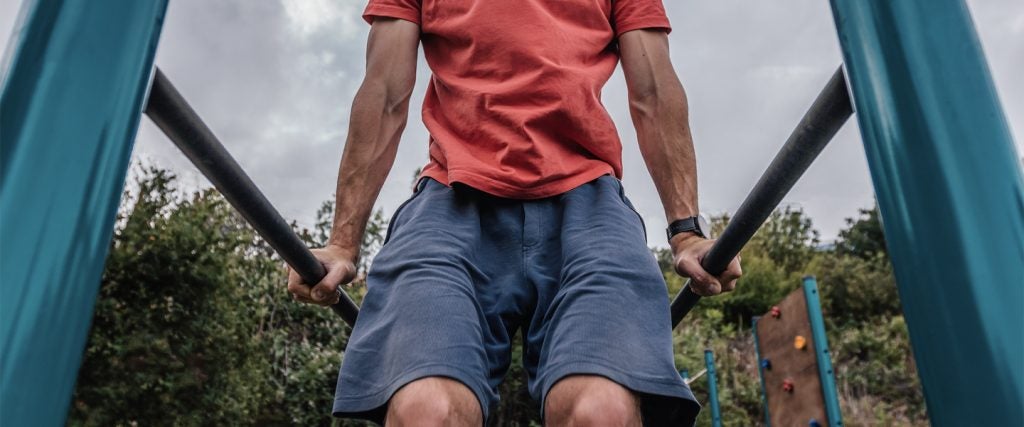Sometimes a resistance movement leaves both your mind and body in a stupor, flummoxed by the challenge and the sensation that surges through your straining muscles. For me, this has always been dips, their degree of difficulty being the very thing that made me immediately fall in love with them. Every swimmer on my high school team could fill 30 seconds with at least 25 push-ups, but very few of us could muster even 12 dips over that same timeframe.
My obsession with the dip singlehandedly resulted in a sharp shift in my teenage Christmas list, a dip stand knocking video games out of the top spot for the first time since I’d been alive.
Wait just a minute — what on earth is a dip?
I know; the only dips you’re familiar with are those involving Freak Nasty.
First off, let’s make sure we’re talking about the correct type of dip. We’re not talking about tricep dips, where you place your hands on a bench beside you, position your legs straight out in front of you, and then lower your butt toward the ground before using your triceps to prop yourself back up. This is one of the exercises that no one should ever do because the internal rotation of the shoulders is eventually going to cause some problems.
Instead, we’re talking about the bodyweight dip, where your hands grasp a set of parallel bars, you press your body straight off the ground so that it’s suspended in mid-air and your arms are straight, and you control your body’s descent until your chest is nearly even with your hands before you press yourself back into the starting position.
And this is considered to be a great exercise?
Some fitness experts have gone so far as to call bodyweight dips “The Upper-Body Squat,” which is a bit of an exaggeration, but still understandable, as there’s a legitimate argument to be made that a beach-worthy upper-body could be crafted using bodyweight dips alone.
When completed correctly, bodyweight dips place a massive emphasis on your chest and triceps, along with your anterior deltoids (aka the fronts of your shoulders). During push-ups, you’re typically lifting around 70 percent of your body weight on average throughout the exercise, while maintaining three to four stable points of contact against the floor depending on where you place your hands and feet. When you perform a dip, you’re lifting at least 90 percent of your body weight with only two points of contact as your lower body dangles, making it far more challenging for your muscles to control the movement of your body, and to maintain control over it to prevent it from swinging and shifting.
Because of the angle at which dips are performed, they work wonders in bulking up and carving out the lower portion of the chest, which can be otherwise difficult to target. It’s also wise to remember that Eugen Sandow and other legendary strongmen of the late 1800s didn’t have access to weight benches, which didn’t gain mainstream popularity until the 1950s. Instead, they relied heavily on dips to pump up their pecs. This is because dips remain a challenging exercise even after you’ve become a famous 19th-century strongman — your added bulk only making things that much hader.
In fact, if you have a set of parallel bars and nothing else at your disposal, you can still rely on dips to propel yourself through an absolutely excruciating training routine that will blitz your chest and triceps, while the rest of your muscles are challenged to maintain optimal body posture.
Why do I hear some people saying that you shouldn’t do dips?
Because dips are among the easiest upper-body exercises to execute sloppily and incorrectly, and doing so can leave your shoulders badly injured. Your shoulders possess ball-in-socket joints as opposed to a hinge joint, which enables them to move in many different directions that aren’t necessarily advantageous to them, even to the extent that the head of the humerus can be yanked out of its protective socket. The closer your body position is to perpendicular to the floor, the more likely you are to engage in the exact sort of internal rotation that results in debilitating shoulder injuries.
Your shoulders are somehow involved with nearly every load-bearing exercise that primarily targets the chest, back and arms. And so, a shoulder injury can be catastrophic, and compromise your ability to efficiently train your upper body ever again. Treat your shoulders like the precious commodity they are, and make sure that if you train with dips, you do so safely by maintaining a 45-degree lean in your upper body.
I don’t know about this. You’re making dips sound grueling at best, and crippling at worst.
At least give dips a try to see if they agree with your shoulders. On the plus side, they could become your go-to method of tending to your chest, triceps and shoulders without ever having to bench press again. And if they don’t, well, at least you’ll know that when someone at the gym is talking about dips, they’re not referring to an early 2000s hip-hop anthem.

